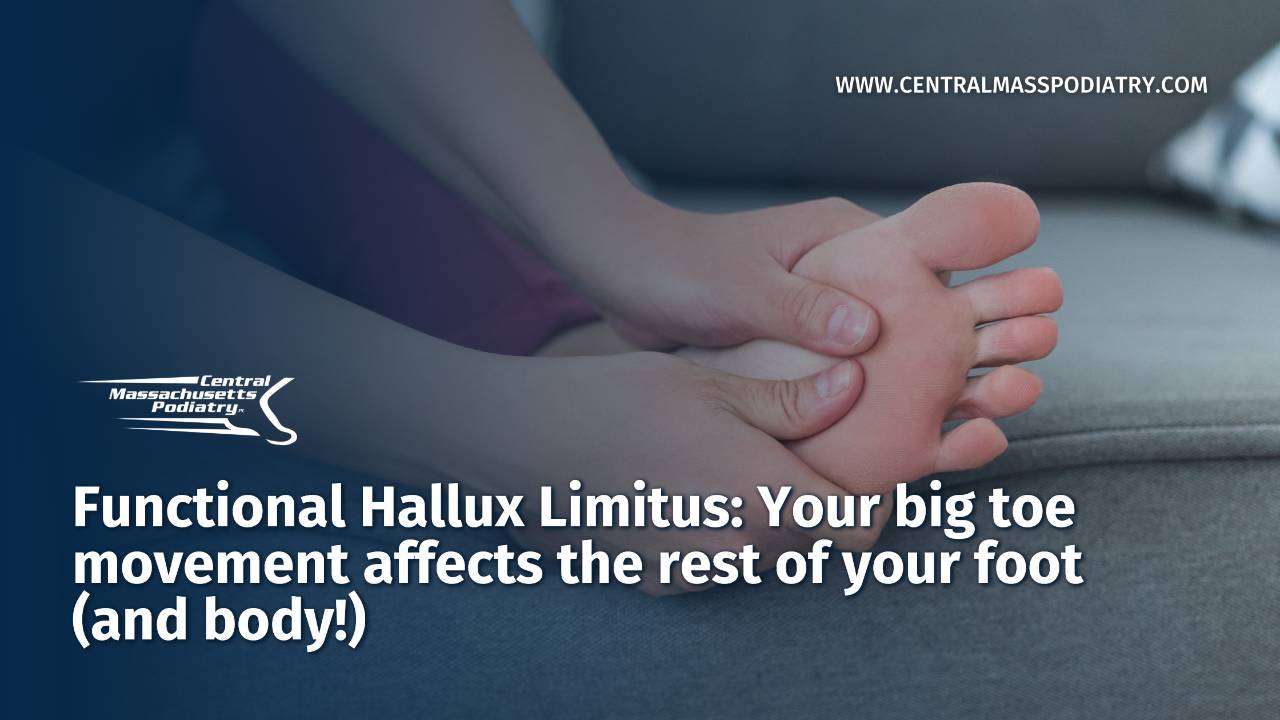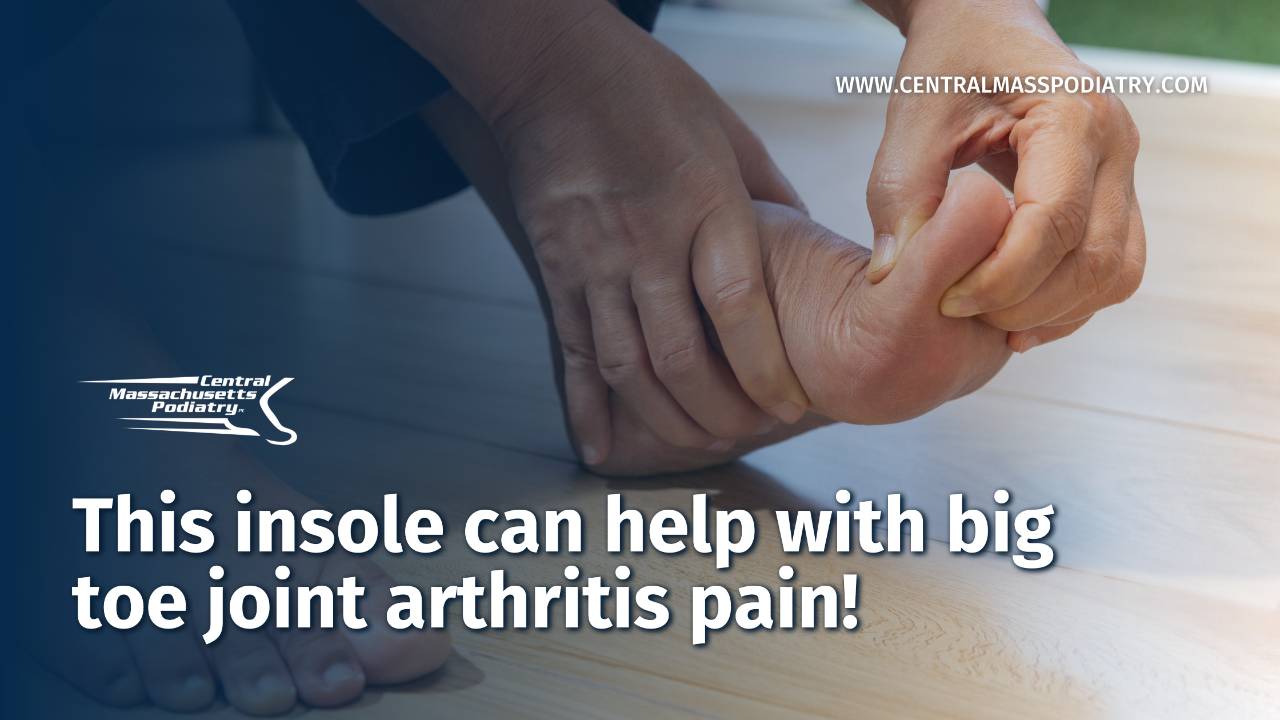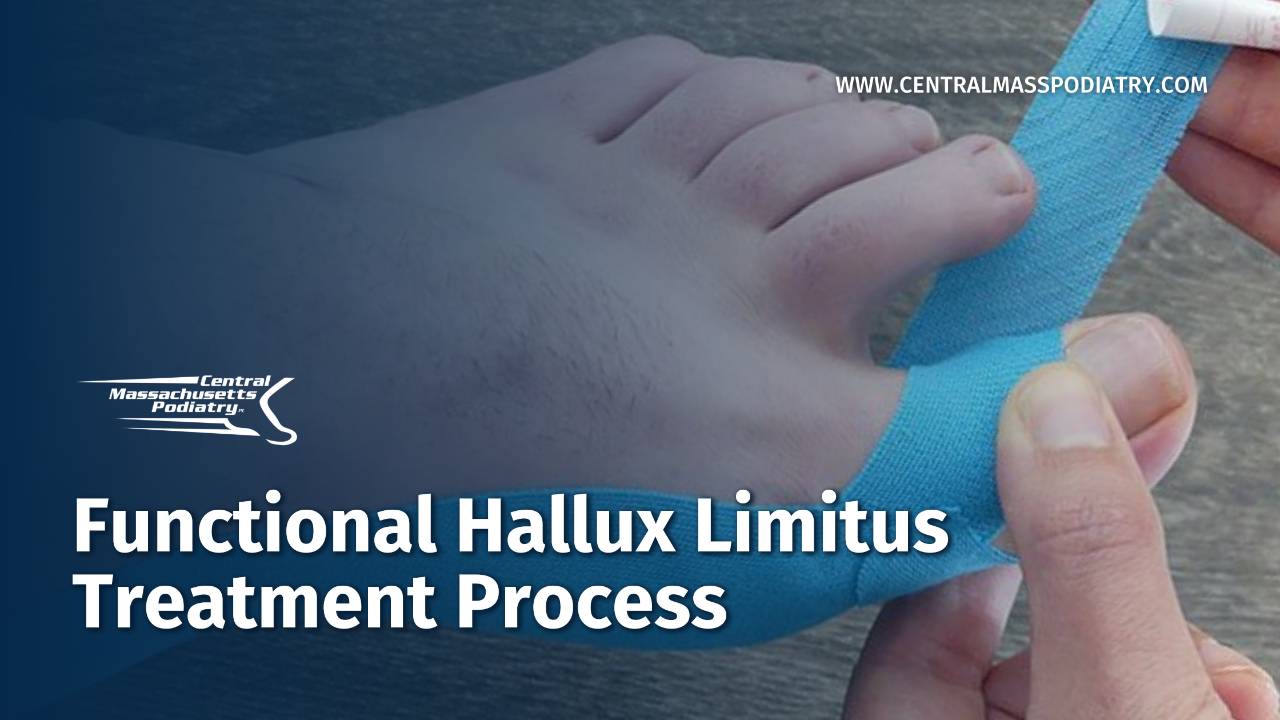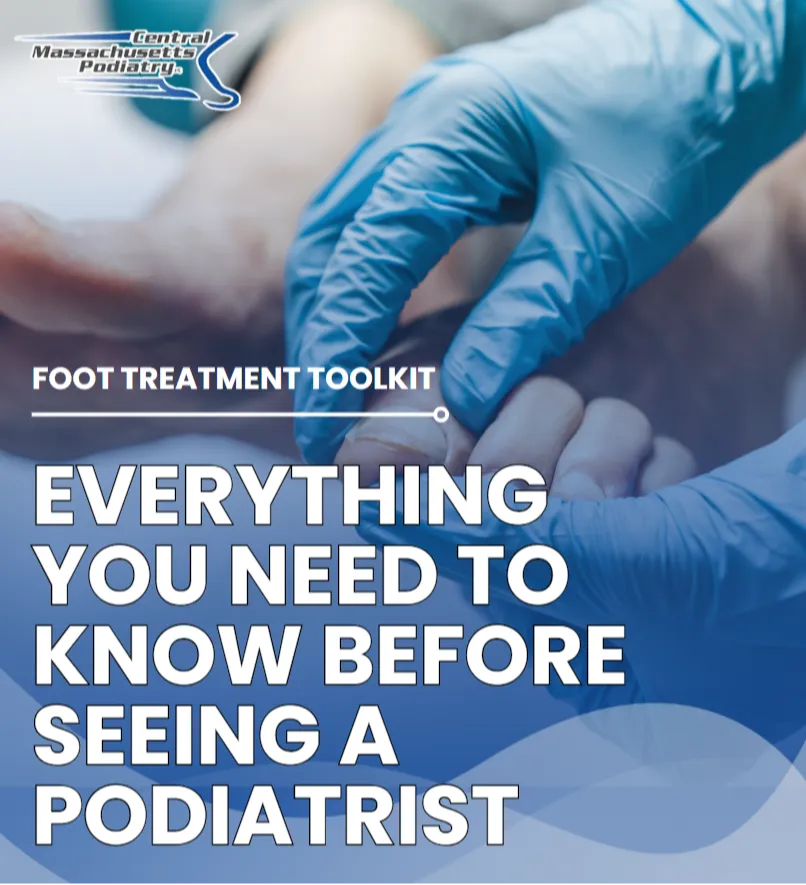Functional Hallux Limitus: Your big toe movement affects the rest of your foot (and body!)

“My big toe hurts” is a common complaint for new patients in our office. There are myriad reasons why a big toe can hurt. These include ingrown toenails, bony prominences, arthritis, gout, infection, bunions, sesamoiditis, fractures. For the purpose of this article, we’re going to discuss the big toe joint, called your first metatarsophalangeal joint. This is the joint where your big toe attaches to the rest of your foot. Its job is to act like a hinge. When the front part of the foot plants against the ground, your foot rotates over and through the big toe joint. This function allows forward motion of the rest of your body to occur over a stable foot. Another way to think about it is that your toe swings up and out of the way when you are about to toe-off during gait.

Big toe joint anatomy: The 1st metatarsal-phalangeal joint (MTPJ) is composed of the 1st metatarsal, the proximal phalanx of the big toe (hallux) and 2 small bones under the 1st metatarsal called sesamoids. The sesamoids will be excluded in the rest of this article for ease of illustration.
This is a more complicated joint than you may think. There are actually 4 bones that interact here. The proximal phalanx is the base of your big toe (hallux). The 1st metatarsal is the long bone behind that (closer to your heel). Lastly, the sesamoids are 2 small oval shaped bones underneath the 1st metatarsal that act like your knee cap, but for your big toe. They serve as a fulcrum to give a muscle (your flexor hallucis brevis muscle, specifically) leverage to pull down towards the floor which allows you to push off harder during the toe-off phase of walking gait. For the purposes of this discussion, the sesamoids aren’t terribly important. They ARE important when discussing arthritis of the big toe joint and surgical options to fix it. A post for another day.
An exam of the 1st metatarsal-phalangeal joint involves several steps. First is inspection-looking for anything obvious like redness, swelling, callus pattern or obvious deformity. Oftentimes, standing x-rays will be obtained so that we can assess the quality of the bone and joint as well as determine the actual position of the toe relative to the metatarsal and sesamoids. The next is palpation (touching) of the joint for areas that cause pain. The range of motion of the joint will also be tested.
A perfectly aligned, healthy 1st metatarsophalangeal joint will have about 65 degrees of motion when tested in a non-weight bearing position. That means your big toe moves up that many degrees relative to the metatarsal. The joint moves on an imaginary axis which is near the middle of the 1st metatarsal head. This exam effectively tests how much potential range of motion is available for the joint. Interestingly, the downward motion of your big toe joint beyond parallel to the ground is not particularly important, unless you have an obscure hobby like playing the piano with your toes.



1st MTPJ Range of Motion: A) Shows a normal joint range of motion. The black circle is the imaginary axis in the middle of the 1st MTPJ that the toe rotates around. B) & C) In the non-weight bearing test, force is only applied to the big toe, without moving the interphalangeal joint. There is no “ground” force being applied to the 1st metatarsal. This test evaluates the potential range of motion of the joint.
The next part of the testing is to evaluate the joint as if it were bearing weight, i.e. how it moves when you stand on it. This exam measures the actual range of motion. This is performed by applying a force under the 1st metatarsal which normally causes a slight elevation of the bone (the star on the diagram), then testing the range of motion of the joint. In a normal healthy joint, this number is reduced, but not far off from the non-weight bearing result. Somewhere around 45 degrees is great. If the joint moves poorly during this test, it is a telltale sign of a condition called FUNCTIONAL hallux limitus. Basically your big toe range of motion is limited when it is trying to function during gait. I will commonly say that it is “jamming up”.



Weight bearing exam: A) In the weight bearing test, force is applied under the 1st metatarsal to simulate the ground, then force is applied to the big toe. The force at the 1st metatarsal causes it to elevate a few millimeters (star), which raises the axis of rotation for the joint and reduces the range of motion slightly. It is a test to evaluate the actual range of motion of the joint. B) and C) Functional hallux limitus joint: The force applied under the first metatarsal causes it to elevate significantly. This elevates the axis of the joint and blocks the ability of the toe to rotate around the axis. This results in a jammed joint, only when weight bearing. Note how little motion can be achieved at the big toe joint.
SIDEBAR: There is another type of hallux limitus called STRUCTURAL hallux limitus which involves something physically blocking the joint from moving, such as bony prominences from arthritis. Structural and functional hallux limitus are siblings. Picture the hinge on a door. Structural hallux limitus is like sticking a screwdriver into the hinge so that it doesn’t move well, or like a rusty hinge. Functional hallux limitus is like the hinge not being stable where it attaches to the door so it doesn’t move through its full range, like a poorly mounted door.

Structural hallux limitus joint: In this case, a bone fragment blocks the range of motion of the joint around the axis. This results in a jammed joint, whether weight bearing or not. The more the joint is damaged, the less range of motion it will have, eventually having no motion at all.
So, big deal, your big toe doesn’t move well. Who cares, right? You’ve got 4 other toe joints right next to it that move fine. That’s not really how it works. There are numerous issues that are caused by functional hallux limitus and poor big toe joint motion.
- Increased pronation -“Collapsed arches”
- External rotation of the foot -“turning your feet outwards”
- Equinus- Increased calf muscle tightness and activation causing your foot to point downward
- Increased loading of neighboring joints and forced increased range of motion there
- Decreased motion and subsequent tightening of the sesamoid complex
- A pinch callus at the medial edge of the joint in the middle of your big toe (hallux interphalangeal joint) caused by rolling off the side of your toe. This also causes ingrown toenails!
This is a scary list if you know what these can cause (Other than the callus, which is mainly just annoying). But even these calluses can lead to painful blisters in runners and walks. So, let’s work from the tip of the joint backwards. The imaginary axis of the hinge is in the middle of the joint, but now it is forced upwards towards the sky so the joint can’t “swing”.
Because your big toe joint does not “roll up” and out of the way, your big toe joint is physically in the way of you moving the rest of your body forward. Now it is blocking your forward momentum. This causes your foot to compensate and to move in ways it shouldn't. Typically patients externally rotate their leg (point your toes outwards) to move away from the blocked joint. Your calf muscles may also have to start working sooner than they are supposed to so you “pole vault” over the dysfunctional joint. Lastly, your foot can collapse allowing the joints further back in your foot to try to make up for the lost motion of the big toe joint. These 3 cheating mechanisms cause issues and, worse, feed on each other. They can cause over-use of nearly the entire foot and ankle complex. Some patients are durable or aren't too active, so this never really catches up with them. In other patients, the compensation can lead to simple annoyances, like symptomatic calluses and traumatized toenails, all the way to “flatfeet”, tendon injuries, stress fractures on other parts of the foot, overload of neighboring joints, symptomatic shin splints (a term I hate), achilles tendon injuries, calf strains and arthritis to foot/ankle joints.
What do we do about it?
There are 2 approaches that work very well together, but can work by themselves in some patients. Both of them address getting the joint to function by dropping the axis of the joint towards the ground instead of it popping up. The path of least resistance, in most cases, is a custom fabricated shoe insert called an orthotic. The slightly more difficult and longer path is focused physical therapy with specific exercises.
With an orthotic, the goal is to allow the 1st metatarsal head to drop down to where it belongs. This allows the hinge to move smoothly. We make a cutout in the carbon fiber shell of the orthotic to create a pocket for the bone to drop into. Sometimes this is all folks need to treat years of pain!

1st ray cutout: By making a cutout under the 1st metatarsal head, gravity helps drop the 1st metatarsal down. This resists the upwards force of the ground better, keeping the axis of the joint positioned well, using all of the available range of motion at the joint. The 1st metatarsal will stay down, allowing the body to hinge/rotate over the 1st MTPJ as the patient toes off during gait.
Other times, an additional modification is made where a small wedge is inserted under the big toe itself. This partially “pre-positions” the big toe in the correct alignment, which then allows the rest of the hinge to move the way it should.

Hallux wedge: In this case, a wedge is used to “pre-position” the toe in a slightly dorsiflexed position. Along with the cutout under the 1st metatarsal head, this helps to further push the 1st metatarsal head down. Again, this keeps the axis of the joint positioned well, allowing for use of all of the available range of motion at the joint.
In nearly all cases, this has to be a custom made device specifically for your foot. Over-the-counter shoe inserts are made mostly to build up an arch and cradle the heel. Heel anatomy has minimal variation from one person to the next if they have the same shoe size. However, as you move from the heel towards the front of the foot, each bone you encounter (talus, navicular, 1st cuneiform, 1st metatarsal, proximal phalanx of the hallux and distal phalanx of the hallux) has variation from one person to the next. By the time you get to the 1st metatarsophalangeal joint, an over-the-counter insert might miss the mark by 1-2 inches which won’t help and may even make you worse. This is why there are almost no companies that make over-the-counter inserts with this type of modification.

Custom Orthotics: Left image shows the side view of a custom device with hallux wedge made of high density red material (lightning bolts). Right image shows bottom view of a custom orthotic device with cutout from shell under the 1st metatarsal head (Blue stars).
With physical therapy, we look at postural alignment/body control and the impact the body has on the foot it moves over. We try to improve the function of a specific muscle called the peroneus longus to pull the metatarsal towards the ground. We also utilize short foot exercises to help strengthen the foot in general. Sounds simple, right? It’s not. You have to constantly activate the muscle with every step until the motor pathway becomes habitual. A physical therapist colleague has told me of incredible successes of some folks learning how to do it well, while for others “It’s like trying to teach a penguin to fly; they have most of the right parts but they’ll never get it right”.

Physical therapy: Some patients will utilize PT to strengthen the peroneal muscles and do short foot exercises. Those help apply a downward and proximal force (orange arrows) that resists the force of the ground pushing up the first metatarsal. A strong peroneus longus will help keep the axis of the 1st MTPJ from deviating upwards when the ground pushes it upwards. This helps allow the body to rotate/hinge over the big toe joint as well.
My method of choice is typically to start with an orthotic if 1)the amount of limitation in the joint is severe 2)it causes compensation or 3) is causing injury to the foot, ankle or elsewhere. I am always willing to have my patients utilize PT, particularly in these cases. Lucky you- the compensation strategies to overcome a blocked big toe joint don’t just stop at the ankle. Many patients often require a full movement screening and assessment of their knees, hips, back and above.
There are some surgical strategies that should be mentioned. Sometimes the 1st metatarsal is grossly unstable at the joint behind the big toe joint, called your 1st metatarsal-cuneiform joint. If that joint is unstable, it causes the 1st metatarsal to pop up at the big toe joint which causes the joint to jam when bearing weight (see everything above!). There is a surgery to stiffen the 1st metatarsal-cuneiform joint which we perform regularly for bunion corrections and can do in cases of severe instability. However, it is only performed in isolated instances after attempting non-surgical measures first.
In summary, our goal is to keep your joints moving the way they should. A big toe joint that jams in the long term will eventually lead to break down of the joint and arthritis as well as cause injuries to other parts of the foot, ankle and rest of the body. A custom orthotic and PT are excellent ways to make the joint function better and help you move better for life and for sports.
AUTHOR

Dr. Benjamin Saviet is a Podiatrist at Central Massachusetts Podiatry, in Worcester and Westborough. He is a board certified rearfoot and ankle surgeon, runner and triathlete. As a former Division 1 runner, he understands how important activities are to his patients. His most important goal when treating all patients is to get them back the activities they love as quickly and safely as possible.
Related Blogs

This insole can help with big toe joint arthritis pain!
I sometimes recommend this Morton’s Extension Carbon…

Surgical Correction of Hallux Limitus (Big Toe Joint Arthritis)
Hallux limitus an arthritic condition that affects the big toe…

Functional Hallux Limitus Treatment Process
This is my current treatment process for patients with…









